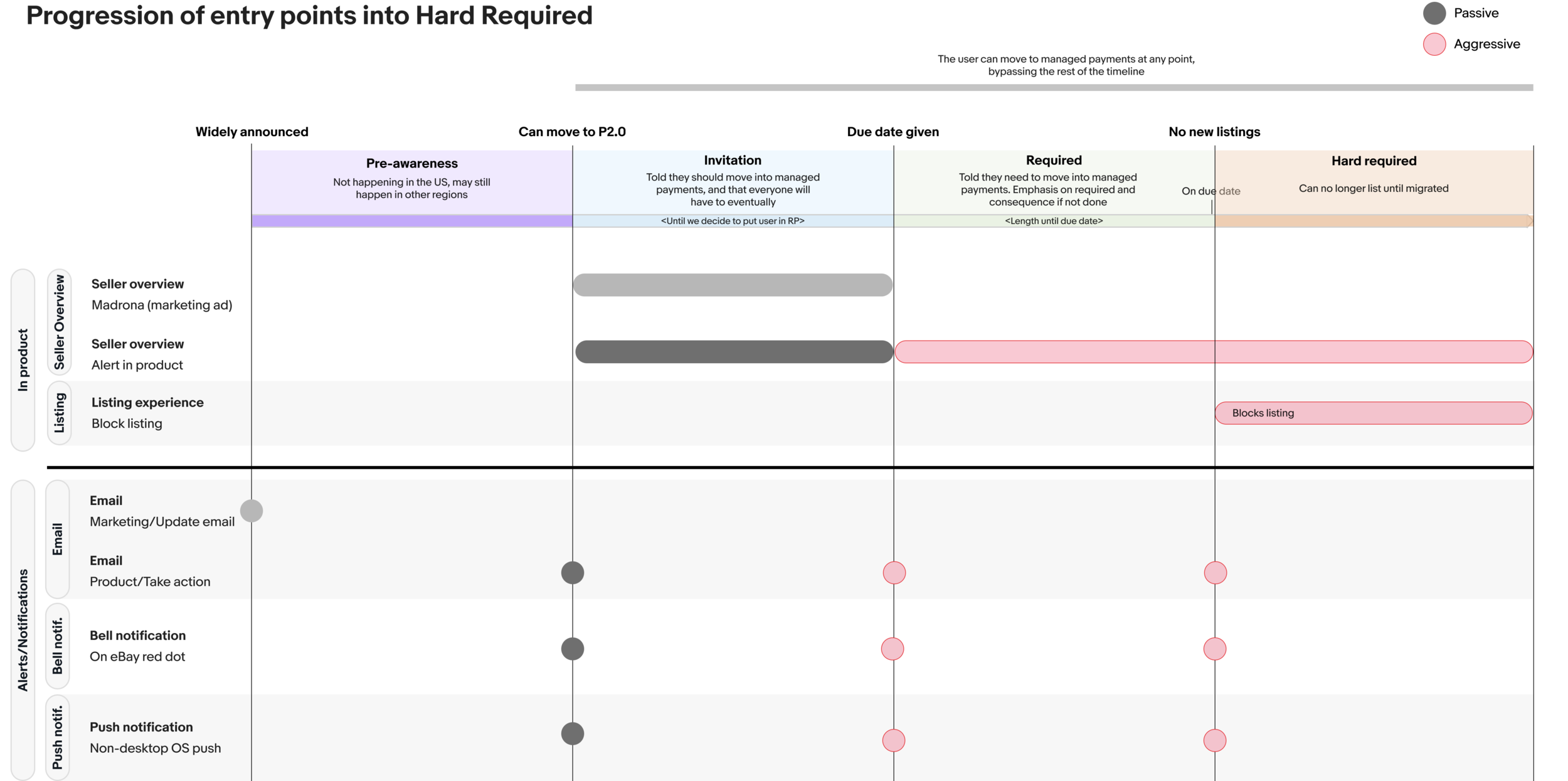Required participation
Date: August 2020
Role: UX Design Lead, spearheaded project and strategy
I worked closely with: Product Managers, Engineering, Business Unit, Content Strategy, Marketing, Cross-site Design teams
Overview
While wrapping up the C2C migration (the flow in which an existing C2C seller must opt into and provide new information for Managed Payments) I knew a strategy would have to be in place to get people to actually migrate. As I didn’t want this to be a last minute rush job, I immediately reached out to the product and business teams to kick off a project looking into how we could progressively push sellers to make the switch.
This project became known as Required Participation.
User group
The focus for this strategy was active C2C (Consumer to Consumer) sellers who would have to move into Managed Payments.
User Problem
As an existing C2C seller, at a certain point I will no longer be able to list unless migrated to Managed Payments. Migrating to Managed Payments is a big change, so I want to feel like I have a choice on when to opt in and I don’t want to be forced into it at the last minute.
How we solved the problem
eBay wants to do everything we can to make sure our sellers are aware of the need to move before the consequences become too dire. Thus, we created a strategy that shows how we can progressively inform the seller as time goes on by putting them through 4 stages.
Design Principles
Give them a chance
Give the seller every opportunity to know this is coming. It shouldn’t be a surprise.
Entry points should be complementary
Rather than looking at entry points one by one in isolation, we should think about how it will be experienced.
Prominent, but not in the way
We want to make sure this is seen, but don’t want to be a nuisance or get in the way of a task until necessary.
Progression to forced migration
In the end, the movement to Managed Payments is not optional and will be required by everyone. The initial business plan was to start giving the C2C sellers the option to move over starting in October 2019, and implementing restrictions for accounts who haven’t moved over by mid-December 2019.
However, we wanted to make sure we didn’t come in too abrasively from the beginning, so I decided to seek out a strategy for how we can engage sellers using progressive urgency.
We knew that we’d be putting our C2C sellers into groups (cohorts) and putting them into Required Participation at different times, so we needed a strategy that could be flexible.
This project focused on the area in blue.
Strategy
Progressive Stages
In order to meet our design principles, we ended up creating 4 stages, with the tone level of content and placements progressing as the date they have to move over comes nearer:
Pre-awareness
Introduce and provide context on the managed payments change. Lets the seller know it’s coming.Invitation
Formally signal change is here and that they should update their information. Once a seller has gone into the Invitation stage, they’ll stay there until their cohort gets assigned a due date.Required
Once a seller’s cohort has been given a due date, we move them to The Required stage. We introduce a date that action is required by and list the consequences if not taken action by then.Hard required with consequence
Enforce the consequence if the seller has not registered by the migration due date assigned to them, let them know how to fix it.
Consequence
Keeping in mind that eBay had a long road ahead until shutting down the old payment system completely, we wanted the consequence to be dire enough so that there would be a strong need to make the move, yet not so strict that it’d totally interrupt a business.
No longer list
We ended up deciding that the consequence would be that the seller can no longer list any new items. They’d still be able to leave up any existing listings they have, continuing to sell them on the old system. This way, they still could run their business, but wouldn’t be able to grow.
The 5th stage
We knew at some point we were going to have to turn off the old way of getting paid. Due to this, we’d have to introduce a 5th stage at some point in the future: Very Hard Required. This stage would take down all existing listings and basically turn off their selling capabilities. For this first launch, we continued to focus on the first 4 stages, but kept in mind we’d have to follow up later to add the final stage.
The 4 stages we ended up going with, with examples on how placements and tone can change for each.
Touchpoints
By talking to the marketing and seller design teams, I came up with 16 possible digital touchpoints for messaging entry points both on and off eBay, as well as a few non-digital opportunities. Looking at these 16, I identified at which stage each would be most effective, keeping in mind our design principle of ‘Prominent, but not in the way’.
Evaluating
I worked closely with the marketing team, product managers and the selling design team to evaluate each touchpoint, mapping out how the full experience would unfold for each option.
First through flow diagrams, laying out how the entry point could affect the flow and what the exit point would be,
Then through mocks, so we could see how the end to end experience would actually feel.
Touchpoints initially explored
Iterations of evaluating touchpoints
Final approach
While we could have easily gone overboard and used all touchpoints, we carefully evaluated the amount of effort vs impact.
We ended up finding that we didn’t need many touchpoints to be effective, as a lot of the touch points were redundant or heavy handed. On top of that, a few would be too much development effort for something we weren’t convinced would make a big enough difference.
In the end we moved forward with 7 touchpoints, a mix of persistent messaging on certain pages and timed notification bursts.

Impact
We ended up running into a lot of development issues in the implementation phase that caused the launch to be moved out several months. In the end it was launched in January 2021. This helped move over 9 million sellers into Managed Payments in a small amount of time.
The 5th stage, Very Hard Required, is now being worked on and will be the final push to getting the remaining hold outs through.








